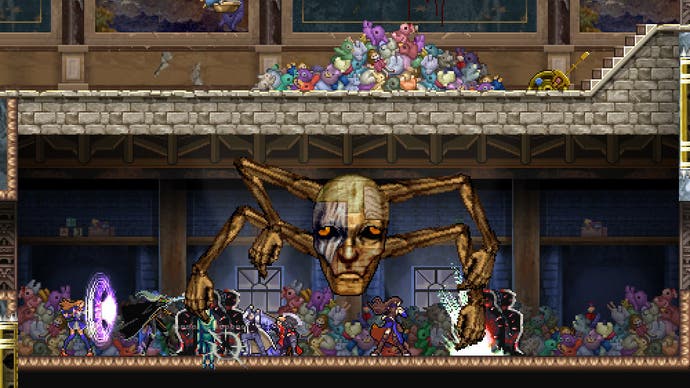Castlevania: Harmony of Despair
All the wrong notes.
It's not an aberration; almost every aspect of Castlevania gets watered down in some fashion. The mansions are shells cobbled together with set-pieces from better games like Aria of Sorrow, laid bare and stripped of their mystique. The variety of enemies is lacking, too, which is hard to explain given the library of monsters that Konami's team had on hand. In the early mansions, the sheer number of axe knights is something out of a fever dream, as if Igarashi fell asleep on the Grim Reaper level of the original Castlevania and never woke up.
In multiplayer mode, each player can revive a fallen comrade (provided they've picked up a Water of Life tchotchke from a treasure chest - irritatingly non-transferable between team members). That means you spend less time restarting each stage. I welcome anything that shortens the Harmony of Despair process, so in that respect, the co-op feature is a winner.
In seriousness, there was a kid-on-a-playground thrill the first time I pulled the picture out and saw friends double-jumping and whipping their way around the same Gothic castle as I was. The sensation wore off, however, as if we were frolicking in a corporate office park: No matter what we did, it was going to feel like work.
Harmony of Despair strips Castlevania down to its lowest common denominator in order to make multiplayer function, rather than reinventing the game to make multiplayer thrive. To ensure that players stay more or less at the same strength, the character-levelling system is scaled way back. The power of some secondary attacks improves, and players can make occasional modest upgrades to weaponry and armour. It's a neutered imitation of the battle systems in the DS Castlevanias, which spoil you with more attacks and magic options than you could ever hope to use.

You can adjust the camera view to three different levels of zoom as you play, taking advantage of the Xbox 360's high-definition canvas so that you can see a huge swathe of the castle and, in theory, follow the exploits of your compatriots. The three available angles are: Impossible To See What's Going On, Somewhat Less Impossible To See What's Going On, and Actually Playable.
There's a survival mode that focuses on combat, which mostly serves to accentuate the aforementioned clumsiness of the movement controls. The co-op mode is the centrepiece. Yet aside from boss fights, where teamwork is essential in the later levels, the opportunities for meaningful co-operation are thin. Many of them involve one person waiting patiently for someone elsewhere in the castle to pull a lever or some such, so you can access a treasure chest that probably contains the same garbage armour you already have. Neither player in this scenario feels like the dashing vampire hunter of box-cover lore, but there is a special Zen impotence in being the guy who stands around doing nothing in the middle of a Castlevania game.
One time, while enduring this forced meditation, I considered what a joy it would be to play a Symphony of the Night-type adventure with a few friends, exploring a castle that had untold hours of secrets to unlock, each of us developing our own fighting styles from an array of possible strategies.
That would be a fantastic journey. It's what this mess of half-ideas and compromises wanted to be. Harmony of Despair isn't a failure of concept but a failure of ambition, one that leaves Koji Igarashi still waiting for his next great discovery.
Castlevania: Harmony of Despair is released on Xbox Live Arcade this Wednesday, 4th August, for 1200 Microsoft Points (£10.20 / €14.40)










